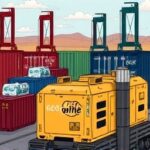In a stark reminder of the economic turbulence that defined 2020, the U.S. job market is reeling from nearly 950,000 announced Layoffs this year alone—the highest total since the height of the COVID-19 pandemic. Major corporations across tech, finance, and manufacturing have slashed jobs at an unprecedented pace, fueling widespread fears of an impending economic downturn. Economists are now warning that if this trend persists, unemployment rates could surge beyond current levels, potentially tipping the nation into recession territory.
Tech Sector’s Brutal Cuts Reshape Silicon Valley
The epicenter of this layoff wave has been the technology industry, where innovation hubs like Silicon Valley are suddenly looking more like ghost towns. Companies such as Meta, Amazon, and Google have collectively announced over 200,000 job reductions in 2023, citing cost-cutting measures amid slowing growth and overhyped investments in AI and metaverse projects. For instance, Meta’s CEO Mark Zuckerberg revealed in a company-wide memo that the firm would eliminate 10,000 positions to streamline operations, emphasizing a shift toward efficiency in a post-pandemic world.
These cuts aren’t isolated; they’re part of a broader recalibration in the tech sector. According to data from Challenger, Gray & Christmas, a global outplacement firm, tech Layoffs accounted for 40% of all U.S. job cuts this year, surpassing even the pandemic-era figures. “The job market in tech was overheated for years, with valuations detached from reality,” said Sarah Johnson, an economist at the Brookings Institution. “Now, as interest rates rise and investor patience wanes, we’re seeing a painful correction that could last well into 2024.”
Workers in affected roles, from software engineers to marketing specialists, are facing not just job loss but a saturated market for new opportunities. Unemployment in the tech field has climbed to 4.2%, up from 2.8% last year, leaving many professionals scrambling for freelance gigs or career pivots. Stories of long-time employees with advanced degrees now applying for entry-level positions underscore the human cost of these corporate decisions.
Manufacturing and Retail Feel the Ripple Effects of Layoffs
Beyond the glitz of Silicon Valley, traditional sectors like manufacturing and retail are bearing the brunt of the layoff surge, amplifying vulnerabilities in the broader U.S. economy. Ford Motor Company, for example, disclosed plans to cut 3,800 jobs at its Michigan plants as electric vehicle production ramps up, while Walmart announced 1,500 corporate layoffs to integrate AI-driven efficiencies. These moves come as supply chain disruptions linger and consumer spending cools, pushing companies to trim payrolls aggressively.
Statistics paint a grim picture: The manufacturing sector has seen 150,000 layoffs year-to-date, the most since the 2008 financial crisis, per the Bureau of Labor Statistics. Retail, hit hard by e-commerce shifts and inflation-weary shoppers, follows closely with 120,000 cuts. “This isn’t just about individual companies; it’s a symptom of structural changes in how Americans buy and produce goods,” noted Dr. Michael Lee, a labor economist at the University of Chicago. In interviews with affected workers, one laid-off assembly line veteran from Ohio shared, “I’ve given 25 years to this factory, and now I’m competing with robots for my next paycheck.”
The knock-on effects are evident in regional economies. Rust Belt states like Ohio and Michigan report unemployment spikes of up to 5.5%, straining local services and housing markets. Small businesses supplying these giants are also suffering, with suppliers facing delayed payments and reduced orders, creating a domino effect that exacerbates the job market’s instability.
Economists Warn of Escalating Unemployment and Recession Risks
As layoff announcements pile up, economists are issuing dire warnings about the trajectory of the U.S. economy, with unemployment projected to rise from its current 3.8% to as high as 5.5% by mid-2024 if trends continue. The Federal Reserve’s aggressive interest rate hikes, aimed at taming inflation, have inadvertently squeezed corporate margins, prompting more cuts. “We’re on the cusp of an economic downturn if consumer confidence doesn’t rebound,” cautioned Federal Reserve Chair Jerome Powell during a recent congressional hearing, highlighting how persistent layoffs could erode household spending—the engine of U.S. growth.
Key indicators support this pessimism. The Conference Board’s Leading Economic Index dropped 0.7% in October, its sharpest decline in months, while job openings have fallen 15% year-over-year. Goldman Sachs analysts predict that without fiscal stimulus, the layoff wave could shave 0.5 percentage points off GDP growth next year. Quotes from Wall Street paint a similar picture: JPMorgan’s Jamie Dimon stated in an earnings call, “The job market is softening faster than anticipated, and we’re preparing clients for a tougher road ahead.”
Demographic shifts add another layer of concern. Younger workers, particularly Gen Z entrants, are hit hardest, with entry-level positions evaporating amid hiring freezes. Women and minorities, often in service-oriented roles, face disproportionate impacts, widening inequality gaps. A recent Pew Research study found that 62% of laid-off workers report heightened financial stress, with many dipping into savings or relying on gig economy apps like Uber to bridge the gap.
Government Initiatives Aim to Stem the Layoff Tide
In response to the mounting layoffs, the Biden administration has rolled out targeted initiatives to bolster the job market and mitigate unemployment spikes. The Department of Labor announced $500 million in retraining grants for affected workers, focusing on high-demand fields like renewable energy and cybersecurity. “We can’t let this economic downturn define the American dream,” President Biden said in a White House address, unveiling the “Back to Work” program to connect laid-off employees with apprenticeships.
Congress is debating broader measures, including an extension of unemployment benefits and tax incentives for companies that retain staff. However, partisan divides loom large; Republicans argue for deregulation to spur hiring, while Democrats push for infrastructure spending to create jobs. State-level actions vary: California, home to many tech layoffs, has launched a $100 million fund for severance support, whereas Texas emphasizes low-tax incentives to attract businesses.
Experts weigh in on effectiveness. “Government intervention can provide a safety net, but it won’t reverse the underlying economic pressures,” opined Elena Ramirez, policy director at the Economic Policy Institute. Non-profits like the National Association of Workforce Boards are partnering with corporations for resume workshops and job fairs, helping thousands transition. Yet, with layoffs outpacing rehiring by a 2:1 ratio, these efforts feel like bandages on a deeper wound.
Future Outlook: Navigating Uncertainty in the U.S. Economy
Looking ahead, the U.S. job market’s resilience will be tested as companies balance cost controls with innovation demands. If inflation eases and the Fed pauses rate hikes, some analysts foresee a stabilization by Q2 2024, with sectors like healthcare and green energy absorbing laid-off talent. However, persistent geopolitical tensions, including trade wars with China, could prolong the downturn, keeping unemployment elevated.
Business leaders are adapting: IBM’s CEO Arvind Krishna announced plans to hire 8,000 workers in hybrid roles, signaling selective growth. For workers, upskilling is key; platforms like Coursera report a 30% surge in enrollments for AI and data analytics courses among the unemployed. Policymakers must act decisively—perhaps through a bipartisan jobs bill—to avert a full-blown recession.
Ultimately, the path forward hinges on collective action. As one economist put it, “The U.S. economy has weathered storms before, but this layoff surge demands vigilance to protect vulnerable workers and sustain growth.” With holiday spending data due soon, any signs of weakness could accelerate fears, underscoring the urgency for proactive measures in this precarious job market landscape.









